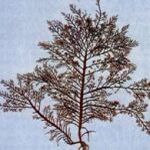| Common Name: |
Chinese Gelatin |
| Botanical Name: |
Gelidium amansii |
| Other Names: |
Agar, Agar, Japanese Isinglass, Vegetable or Japanese Gelatin, Tensuga,
|
| Genus: |
Gelidium |
| Family Name: |
Gelidiacea |
| History: |
Product obtained from several species of red algae, or seaweed , chiefly from the Ceylon, or Jaffna, moss (Gracilaria lichenoides) and species of Gelidium, harvested in eastern Asia and California. Chemically, agar is a polymer made up of subunits of the sugar galactose; it is a component of the algae's cell walls. Dissolved in boiling water and cooled, agar becomes gelatinous; its chief uses are as a culture medium (particularly for bacteria) and as a laxative, but it serves also as a thickening for soups and sauces, in jellies and ice cream, in cosmetics, for clarifying beverages, and for sizing fabrics.
A genus of about 20 species of red seaweeds, found mainly in waters off Japan, Spain, Portugal, W. Scotland, Ireland, N, S, and W. Africa, Madagascar, California, and Chile. They are collected with rakes from boats or by divers from deep water, and are now cultivated by the Japanese on poles in coastal waters. Gelidium amansii is a source of agar or kanten, a colloidal extract used in similar ways to gelatin. The earliest observations of the properties of G. amansii (tengusa) are attributed to a Japanese innkeeper, Minoya Tarozaemon, in 1660, though seaweed gels have been eaten in Japan for over 1200 years. Its use as agar, a culture medium for bacteria, was developed in the 1880's by Robert Koch, who thereby discovered the organisms that cause tuberculosis. Some 30 species of algae, belonging to about ten different genera, are used worldwide for agar production; the main ones are G. amansii (Japan), G. cartilagineum (USA), Gracilaria verrucosa (Australia), and Pterocladia pinnata (New Zealand). The 20th century saw demand for Gelidium increase in many areas, including medicine, dentistry, forensic science, and the food industry. It is prepared as strips of solidified mucilaginous extract, which gels at 32°C (90°F) and melts at 85°C (185°F). The high melting point makes agar useful in foods that might otherwise melt in warm temperatures. In addition, its constituents are non-toxic and not absorbed from the gut. |
| Habitat: |
Ocean coastal regions |
| Cultivation: |
In shallow coastal water on poles. |
| Propagation: |
By spores, which spread naturally. |
| Harvest: |
Plants are collected during the growing season and sun-dried before processing into dried agar strips and powder. |
| Properties: |
A nutritive, almost tasteless, gelatinous herb that acts as a bulk laxative. |
| Medicinal Uses: |
A nutritive jelly for invalids, relieves inflammation reduces constipation, a culture medium in labratories, mild stimulating laxative. |
| Culinary Uses: |
Powdered or flaked agar is used to set jellies. Kanten is a popular food in Japan, made into a firm jelly or into tokoroten (noodles). |
| Economic Uses: |
Used in invalid foods, and as a gelling and stabilizing agent in canned meats, ice cream, sauces, deserts, and dairy products. |
| Preparation and Dosage: |
Bleached in the sun then boiled and the mucilaginous liquid is strained dried and then cut into strips
One hundreds parts water to one part agar boiled 10 mins to produce jelly.
Powdered agar can be sprinked on stewed fruits to aid in constipation
Combine with mineral oil to create a mild laxative. |
| Parts Used: |
Whole Plant. |
| Location: |
China and Japan |
| Classification: |
Algae |
| Bibliography: |
Encyclopedia of Medicinal Herbs ~ by Joseph Kadans, N.D. Ph. D. ~ Copyright © 1970 Parker Publishing Company, Inc.~ pp 23-24
Encyclopedia.org
Encyclopedia of Herbs ~ Deni Bown ~ Copyright © 1995, 2001, Doring Kindersley Limited ~ pg. 221 |

